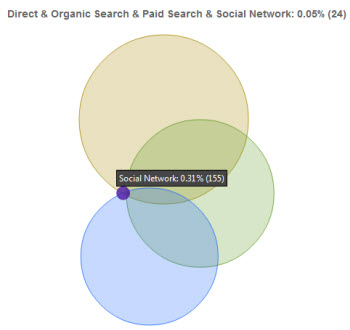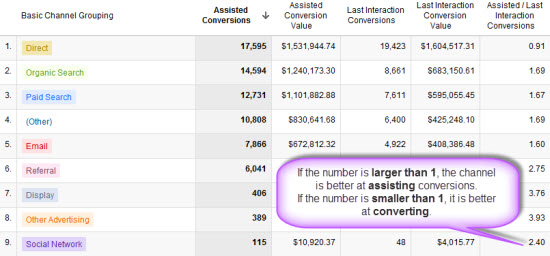How To Get Actionable Data From Google Analytics & Answer The "So What?" Question
If you have ever generated an analytics report, you know what the problem is – nobody reads them. All your pretty charts end up in the trash and you have a feeling that you wasted your time. The bad news is that, perhaps, those reports lacked analysis. The good news is that you are not alone.
Here is the better news – those reports are fixable.
They were missing the answer to the ultimate question – "So what?"
Say, you rank for a thousand keywords. So what? Is it bad or is it good? Should you be ranking for millions keywords? Or, should you be dancing a victory dance? You will not be able to navigate your data without actionable analytics reports.
Unlike popular belief, the proof is not in the pudding, but in smart analysis. It starts with goals. You need to know what you want to achieve and how to recognize success when you see it. Setting targets will allow you to put a face to a hypothesis. Tracking key performance indicators (KPIs) will ensure you are not flying blind.
 Before you start any marketing campaign, you start with goals rooted in objectives, targets and KPIs. When formulating your objective, state clearly, why you need to create this campaign. Then, describe what you can realistically achieve with the resources you have. Your statements need to be brief and specific. Do not forget to include benefits to the business.
Before you start any marketing campaign, you start with goals rooted in objectives, targets and KPIs. When formulating your objective, state clearly, why you need to create this campaign. Then, describe what you can realistically achieve with the resources you have. Your statements need to be brief and specific. Do not forget to include benefits to the business.
I am going to use an example, "Expand brand recognition as a consulting company, not just software company." It is clear, that consulting services need more exposure. There are probably resources in place to highlight a different side of the business. Expanding market reach is beneficial because it will likely increase revenue.
 Once the overall objective is formulated, let's talk strategy. The main goal is to increase consulting customers. A good way to expand market reach is through social channels. Here is the strategy: "Increase consulting customers through promotions on social channels." And here is the target: "Increase consulting customers by 10%." If the campaign is successful, there will be increase in social mentions of the consulting services, higher impression share on searches. Those will be your KPIs, along with number of conversions (new consulting customers).
Once the overall objective is formulated, let's talk strategy. The main goal is to increase consulting customers. A good way to expand market reach is through social channels. Here is the strategy: "Increase consulting customers through promotions on social channels." And here is the target: "Increase consulting customers by 10%." If the campaign is successful, there will be increase in social mentions of the consulting services, higher impression share on searches. Those will be your KPIs, along with number of conversions (new consulting customers).
Dive deep in the planning process and create something like this Marketing and Measurement Model.
Now you are ready for actionable reports.

Your reports need to support your overall objective and goals. You cannot get any insight from just one lonely metric. You need perspective. As a start, look at the traffic and compare it to the previous month. Better yet, include conversions and revenue. That way you are making your metric more relevant to business goals.
In our example case, we are trying to increase exposure through social channels. In analytics reports, segment data by channel and examine the social channel. Don't be afraid to segment the data even further. Look at specific sites and campaigns, evaluate engagement activities, check out conversions during different times of the day. How else would you know what is working and what failed?
Do not forget your multi-channel funnels. If you are expanding your social efforts, pay attention to how social channels contribute to conversions through other channels. Traditionally, conversations start on Twitter, Facebook, Google Plus but conversions happen through other channels.

Expect your social efforts to jump-start more conversions through organic search, paid campaigns, direct traffic, email, etc. Assisted conversions report in Google Analytics will help you understand the interactions specific to your website. You can find the report under Conversions -> Multi-Channel Funnels.

In order to get all social campaigns references, do not forget to tag your URLs properly. Use structured social sharing and track your efforts.
 Practice predictive analytics, look for patterns in your data. If you notice a trend, you will be prepared for changes and have your resources ready when you need them. For example, if your social efforts show steady increase in conversions through paid advertising, you'd better figure out how to adjust your PPC budget. One way to identify a trend is to track changes in data patterns.
Practice predictive analytics, look for patterns in your data. If you notice a trend, you will be prepared for changes and have your resources ready when you need them. For example, if your social efforts show steady increase in conversions through paid advertising, you'd better figure out how to adjust your PPC budget. One way to identify a trend is to track changes in data patterns.
Let's say, someone from your company did a presentation at a conference about your consulting services. As a result, your referral traffic and conversions went up. Perhaps, you can now target the visitors coming from those referral sites. You can post a guest blog on those sites, display some targeted content just to those specific visitors, or send the speaker to more conferences. On the other hand, if the referrals increase, but the conversions stay the same, it might be better to cool your heels and focus on more beneficial efforts.
 1. Have goals. You cannot act if you do not know where you are going. Goals and targets are essential to actionable analytics.
1. Have goals. You cannot act if you do not know where you are going. Goals and targets are essential to actionable analytics.
2. Use segments to focus on what matters. When running campaigns, do not distract yourself with extra data. Use your reports to measure your specific efforts. And always link the performance to revenue.
3. Watch patterns and trends for better resource allocation. Anticipate changes in your traffic or user behavior or conversions. Be prepared for a change ahead of time instead of reacting to it when it happens.
You can always find more examples of how to make your Analytics actionable.
Now you have a starting point to make all your reports actionable. When creating analytics reports, always know what exactly the reports are going to show you – new opportunities, key performance metrics, or trends. And keep asking that "so what?" question when looking at data. Only then you will have a chance to make a hole in one.
rtechinsane,icodesource,SEO,SEO Tips,SEO Backlinks,SEO content,SEO tricks,SEO Engine,codes,gadgets,iphones,ipad,4G phones,geeks,reviews,database,DBMS,
Here is the better news – those reports are fixable.
They were missing the answer to the ultimate question – "So what?"
Say, you rank for a thousand keywords. So what? Is it bad or is it good? Should you be ranking for millions keywords? Or, should you be dancing a victory dance? You will not be able to navigate your data without actionable analytics reports.
Unlike popular belief, the proof is not in the pudding, but in smart analysis. It starts with goals. You need to know what you want to achieve and how to recognize success when you see it. Setting targets will allow you to put a face to a hypothesis. Tracking key performance indicators (KPIs) will ensure you are not flying blind.
Objectives, Goals, Targets, KPIs
 Before you start any marketing campaign, you start with goals rooted in objectives, targets and KPIs. When formulating your objective, state clearly, why you need to create this campaign. Then, describe what you can realistically achieve with the resources you have. Your statements need to be brief and specific. Do not forget to include benefits to the business.
Before you start any marketing campaign, you start with goals rooted in objectives, targets and KPIs. When formulating your objective, state clearly, why you need to create this campaign. Then, describe what you can realistically achieve with the resources you have. Your statements need to be brief and specific. Do not forget to include benefits to the business.I am going to use an example, "Expand brand recognition as a consulting company, not just software company." It is clear, that consulting services need more exposure. There are probably resources in place to highlight a different side of the business. Expanding market reach is beneficial because it will likely increase revenue.
 Once the overall objective is formulated, let's talk strategy. The main goal is to increase consulting customers. A good way to expand market reach is through social channels. Here is the strategy: "Increase consulting customers through promotions on social channels." And here is the target: "Increase consulting customers by 10%." If the campaign is successful, there will be increase in social mentions of the consulting services, higher impression share on searches. Those will be your KPIs, along with number of conversions (new consulting customers).
Once the overall objective is formulated, let's talk strategy. The main goal is to increase consulting customers. A good way to expand market reach is through social channels. Here is the strategy: "Increase consulting customers through promotions on social channels." And here is the target: "Increase consulting customers by 10%." If the campaign is successful, there will be increase in social mentions of the consulting services, higher impression share on searches. Those will be your KPIs, along with number of conversions (new consulting customers).Dive deep in the planning process and create something like this Marketing and Measurement Model.
Now you are ready for actionable reports.
Segmentation

Your reports need to support your overall objective and goals. You cannot get any insight from just one lonely metric. You need perspective. As a start, look at the traffic and compare it to the previous month. Better yet, include conversions and revenue. That way you are making your metric more relevant to business goals.
In our example case, we are trying to increase exposure through social channels. In analytics reports, segment data by channel and examine the social channel. Don't be afraid to segment the data even further. Look at specific sites and campaigns, evaluate engagement activities, check out conversions during different times of the day. How else would you know what is working and what failed?
Do not forget your multi-channel funnels. If you are expanding your social efforts, pay attention to how social channels contribute to conversions through other channels. Traditionally, conversations start on Twitter, Facebook, Google Plus but conversions happen through other channels.

Expect your social efforts to jump-start more conversions through organic search, paid campaigns, direct traffic, email, etc. Assisted conversions report in Google Analytics will help you understand the interactions specific to your website. You can find the report under Conversions -> Multi-Channel Funnels.

In order to get all social campaigns references, do not forget to tag your URLs properly. Use structured social sharing and track your efforts.
Looking for Patterns
 Practice predictive analytics, look for patterns in your data. If you notice a trend, you will be prepared for changes and have your resources ready when you need them. For example, if your social efforts show steady increase in conversions through paid advertising, you'd better figure out how to adjust your PPC budget. One way to identify a trend is to track changes in data patterns.
Practice predictive analytics, look for patterns in your data. If you notice a trend, you will be prepared for changes and have your resources ready when you need them. For example, if your social efforts show steady increase in conversions through paid advertising, you'd better figure out how to adjust your PPC budget. One way to identify a trend is to track changes in data patterns.Let's say, someone from your company did a presentation at a conference about your consulting services. As a result, your referral traffic and conversions went up. Perhaps, you can now target the visitors coming from those referral sites. You can post a guest blog on those sites, display some targeted content just to those specific visitors, or send the speaker to more conferences. On the other hand, if the referrals increase, but the conversions stay the same, it might be better to cool your heels and focus on more beneficial efforts.
Putting it All Together
 1. Have goals. You cannot act if you do not know where you are going. Goals and targets are essential to actionable analytics.
1. Have goals. You cannot act if you do not know where you are going. Goals and targets are essential to actionable analytics.2. Use segments to focus on what matters. When running campaigns, do not distract yourself with extra data. Use your reports to measure your specific efforts. And always link the performance to revenue.
3. Watch patterns and trends for better resource allocation. Anticipate changes in your traffic or user behavior or conversions. Be prepared for a change ahead of time instead of reacting to it when it happens.
You can always find more examples of how to make your Analytics actionable.
Now you have a starting point to make all your reports actionable. When creating analytics reports, always know what exactly the reports are going to show you – new opportunities, key performance metrics, or trends. And keep asking that "so what?" question when looking at data. Only then you will have a chance to make a hole in one.
rtechinsane,icodesource,SEO,SEO Tips,SEO Backlinks,SEO content,SEO tricks,SEO Engine,codes,gadgets,iphones,ipad,4G phones,geeks,reviews,database,DBMS,


0 comments:
Post a Comment